MARIANI’S
Virtual Gourmet
OCTOBER
6, 2019
NEWSLETTER

❖❖❖
IN THIS ISSUE
SIRMIONE
By Geoff Kalish
NEW YORK CORNER
DEL FRISCO'S STEAKHOUSE
By John Mariani
NOTES FROM THE WINE CELLAR
VEGA SICILIA
By John Mariani
❖❖❖
SIRMIONE
By Geoff Kalish
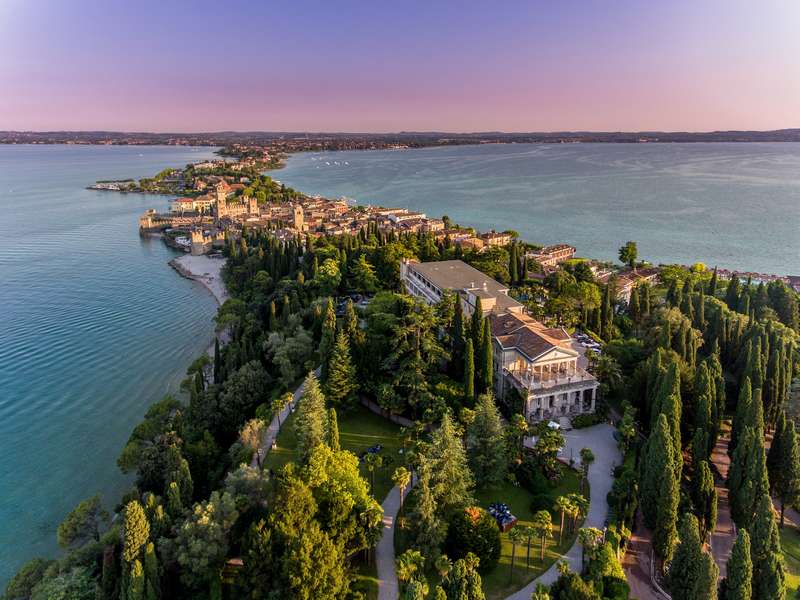
Some
30 years ago Sirmione, set at the tip of a
peninsula jutting into the southern end of Lake
Garda in northern Italy, was a modestly popular
destination for a summertime visit, featuring
narrow streets lined with local boutiques. Now,
like most of Italy between mid-June and the end
of August, it teems with tourists and is loaded
with gelato shops.
Of course, wine is important
throughout the region, and prosecco from nearby
wineries remains a popular aperitif, especially in
an Aperol Spritz, a mix of prosecco and Aperol
combined with a splash of soda and served on ice
with a slice of orange. In fact, on recent
afternoons I saw this beverage being sipped by
more than half the patrons on the main outdoor
plaza in Sirmione, as well as at tables in Venice,
Verona and Milan.
Sirmione contains a 13th
century Castle named Rocca Scaliger that features
massive towers and thick walls on top of which
visitors can walk and take in a view of the lake.
There’s also a number of ancient churches worth
visiting, like Chiesa di San Pietro in Mavino and
Chisetta di S. Ann, and the well-preserved ruins
of a First century Roman villa, Gtotte Catulo, a
beach, a children’s playground, as well as some
upscale boutique shops like Max Bulian on Via
Vittorio Emanuelle for men and Nostalgia on Via
Casello for women, along with some interesting
bargain boutiques.
At the far edge of the town
there’s Villa Cortine Palace, a luxury hotel with
magnificent grounds, plush, spacious rooms, a pool
overlooking the lake and a private lakeside area
with a pier from which guests can swim or relax on
lounge chairs.
The restaurant, Al Molo, features top-notch
freshly made pasta specialties and grilled
seafood, chops and steak. The hotel also offers
scenic, outdoor upscale dining in a garden setting
behind its main building.
As to other dining in Sirmione,
there are more than a few good options, ranging
from simple trattorias serving pizza to full-scale
ristoranti.
 Ristorante
Risorgimento
Ristorante
Risorgimento
Piazza
Giusuè Carducci 5/6
39-030-916325
Although the indoor space is
quite elegant, with well-spaced, white-clothed
tables in a room featuring white walls and sheer
window coverings, on dry summer days outdoor
seating at this 100-year-old ristorante
along a large plaza ringed by other restaurants is
preferred. In both, the fare prepared under the
direction of long-time chef and owner Amedo Baroni
is artistically presented sophisticated modern
takes on traditional Italian dishes.
For example, an appetizer of
open ravioli (right)
was a plate of large squares of thin green and
white pasta atop a saffron-infused sauce and
coated with a beef and burrata mix dusted with
grated Parmigiano. Shrimp and prawns out of
their shells (left)
were coated with a delicate swirl of crisp, thin
shreds of potato and served with four different
fragrant dipping sauces. Likewise, main courses of
juicy sea bream on a mound of light tomato compote
and one of dewy turbot tasted every bit as good as
they looked. We accompanied the meal with a 2015
Luce Della Vite Lucente from Montalcino that had
flavors of ripe cherries and strawberries with
notes of thyme in its finish, and we concluded
with a large scoop of gelato coated with rich, hot
chocolate sauce and a glass of toffee-flavored Ben
Rye Passito from Donnafugata in Sicily.
(Open for
lunch and dinner daily, except Tues. Expect
dinner for two to cost $130-$140, excluding wine
and tax.)
Tavernetta
Maria
Callas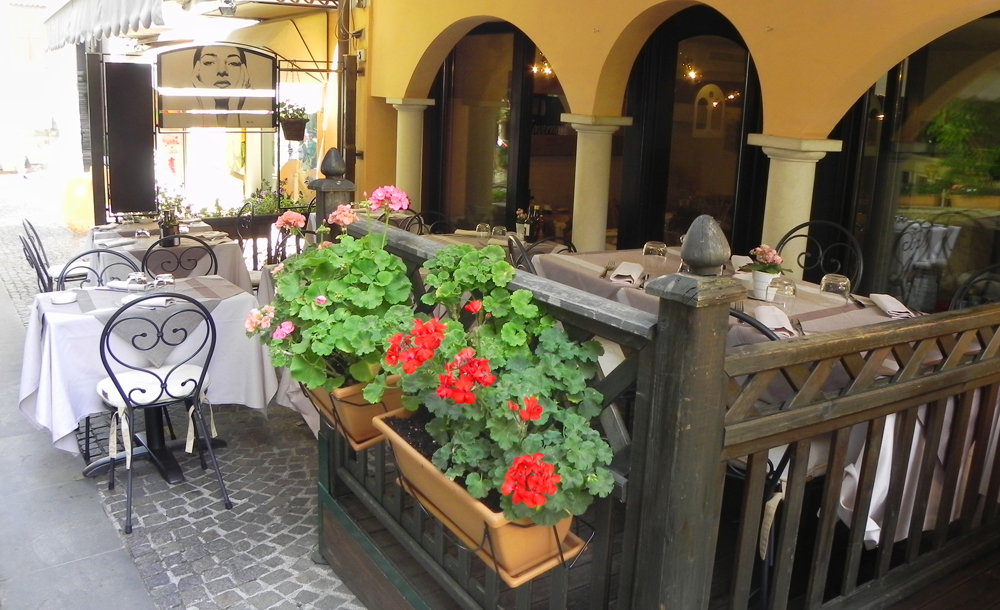
Via S.
Salvatore
39-030-916248
Named by owner Daniele Prodi after
the Greek opera diva, who at the height of her
career lived in a villa in Sirmione, Maria Callas
offers indoor and outdoor seating. Indoors is a
room with white walls, a brown wooden floor and
clothed tables, where the piped in music consists
of arias by the 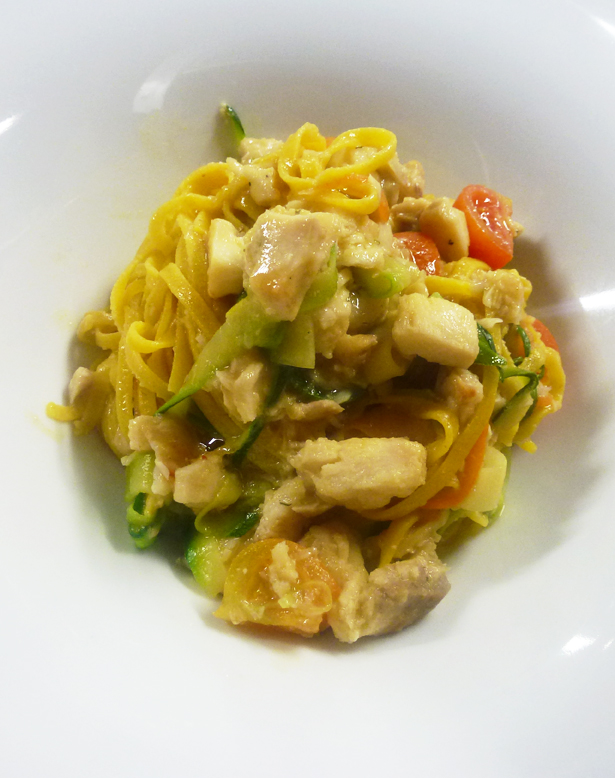 restaurant’s
namesake. Outdoors tables are set in front of the
restaurant along a wide cobblestone street.
restaurant’s
namesake. Outdoors tables are set in front of the
restaurant along a wide cobblestone street.
The food is creative regional
Italian, and appetizer choices include: large deep
fried zucchini flowers stuffed with chive-laced
cottage cheese accompanied by a zesty tartar
sauce; tender tentacles of seared octopus served
with candied orange slices and pistachios; a flan
of earthy wild mushrooms on Parmigiano fondue with
roasted pears; and beef tartare served with a
salad of fresh spinach, raspberries and salted
cottage cheese.
And there are ten different
pasta and risotto dishes, like house-made tagliatelle with
black
 truffles and a heady mix
of cuttlefish ink, and fusilli accompanied by
squid and zucchini tossed with mint and chili
pepper. Main courses run the gamut from eight
choices of sea fare, like moist, seared wild sea
bream with cauliflower cream (right), to
seven choices of meats, like a fillet of beef with
foie gras and mushrooms doused in an Amarone-based
sauce. We accompanied the meal with a 2016
full-bodied Ripa Della Volita Valpolicella Ripasso
that had flavors of plums and wild herbs and
concluded with a slice of creamy cheese cake
served with wild strawberries and a dish of green
apple sorbet.
truffles and a heady mix
of cuttlefish ink, and fusilli accompanied by
squid and zucchini tossed with mint and chili
pepper. Main courses run the gamut from eight
choices of sea fare, like moist, seared wild sea
bream with cauliflower cream (right), to
seven choices of meats, like a fillet of beef with
foie gras and mushrooms doused in an Amarone-based
sauce. We accompanied the meal with a 2016
full-bodied Ripa Della Volita Valpolicella Ripasso
that had flavors of plums and wild herbs and
concluded with a slice of creamy cheese cake
served with wild strawberries and a dish of green
apple sorbet.
(Open daily
except Tues. for lunch and dinner. Expect dinner
for two to cost $100-$110, excluding wine and
tax.)
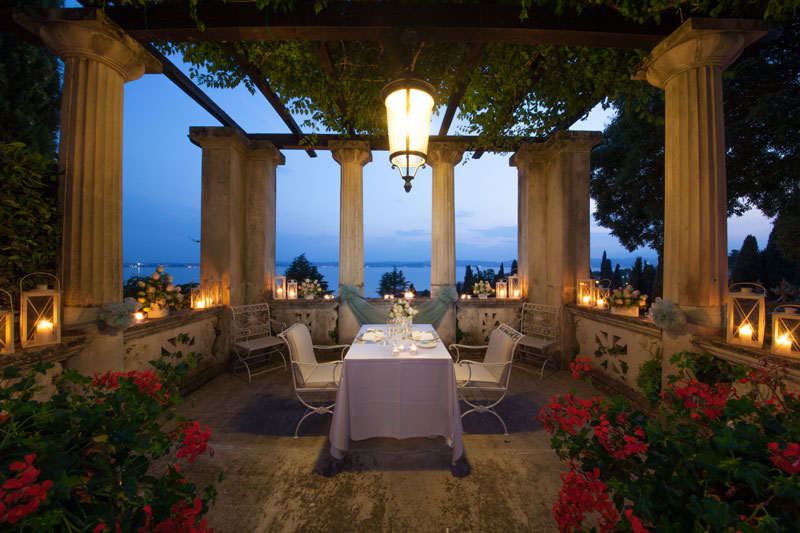 Le Gardenie
Restaurant
Le Gardenie
Restaurant
Villa Cortine Palace Hotel
Viale Gennari 2
39-030-990-5890
Dining here takes place at
white-clothed tables set well apart in a large
walled garden overlooking Lake Garda at the rear
of the Villa Cortine Palace Hotel, a grand
structure built in the 11th century as a family
fortress. In inclement weather, it’s indoors in a
luxurious room that looks out at the garden.
Service is prompt and professional and 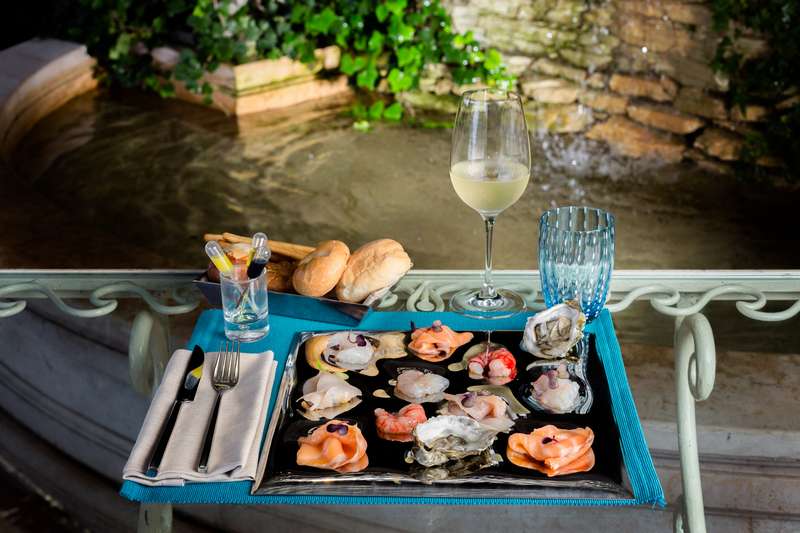 the
extensive menu offers a wide range of creative
dishes, primarily representative of northern
Italian fare, and many with an Asian/Mideastern
flair. For example, an appetizer of crispy shrimp
came dressed in passion fruit cream, lime ricotta
and a tangy wasabi vegetable mayonnaise. Grilled
squid were accompanied by a roasted pumpkin puree
laced with mustard and coriander. Even a risotto
dish was loaded with squid and scallops infused
with a coriander gel, while a
the
extensive menu offers a wide range of creative
dishes, primarily representative of northern
Italian fare, and many with an Asian/Mideastern
flair. For example, an appetizer of crispy shrimp
came dressed in passion fruit cream, lime ricotta
and a tangy wasabi vegetable mayonnaise. Grilled
squid were accompanied by a roasted pumpkin puree
laced with mustard and coriander. Even a risotto
dish was loaded with squid and scallops infused
with a coriander gel, while a 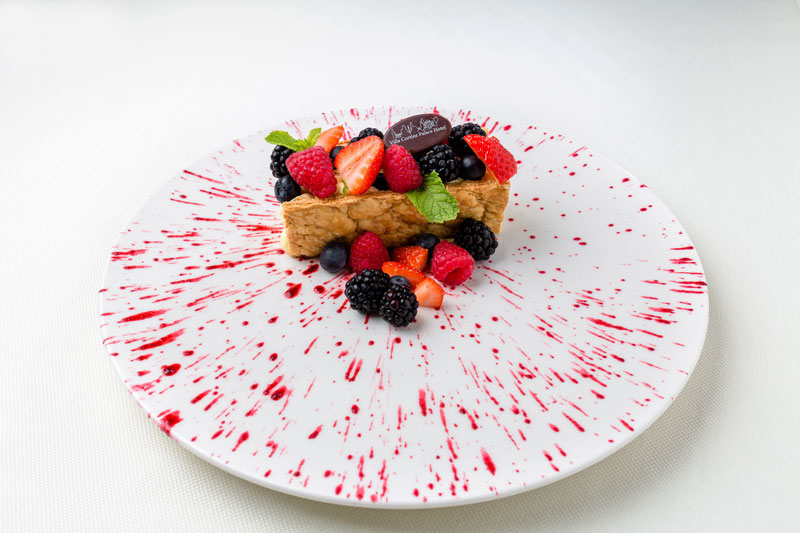 main course of octopus
with fennel, fried eggplant and baby carrots was
spiced with heady ginger.
main course of octopus
with fennel, fried eggplant and baby carrots was
spiced with heady ginger.
There is, however, no
Asian/Mideastern influence in the serving of meaty
chops of suckling pig, doused in a classic rich
Italian Amarone sauce and served with sautéed
Brussels sprouts seasoned only with salt and
pepper. Also, desserts are classic Italian ranging
from tiramisù to cheese cake to a selection of
cheeses. We accompanied the meal with a 2014
Tedeschi San Rocco Valpolicella Sureriore Ripasso
with a bouquet and taste of plums, cherries and
raspberries that mated well with the diverse
flavors of the fare.
Open for
dinner nightly. Expect dinner for two to cost
$160-$170, excluding wine and tax.
❖❖❖
By John Mariani
1221 Avenue of the Americas (at 49th Street)
212-575-5129
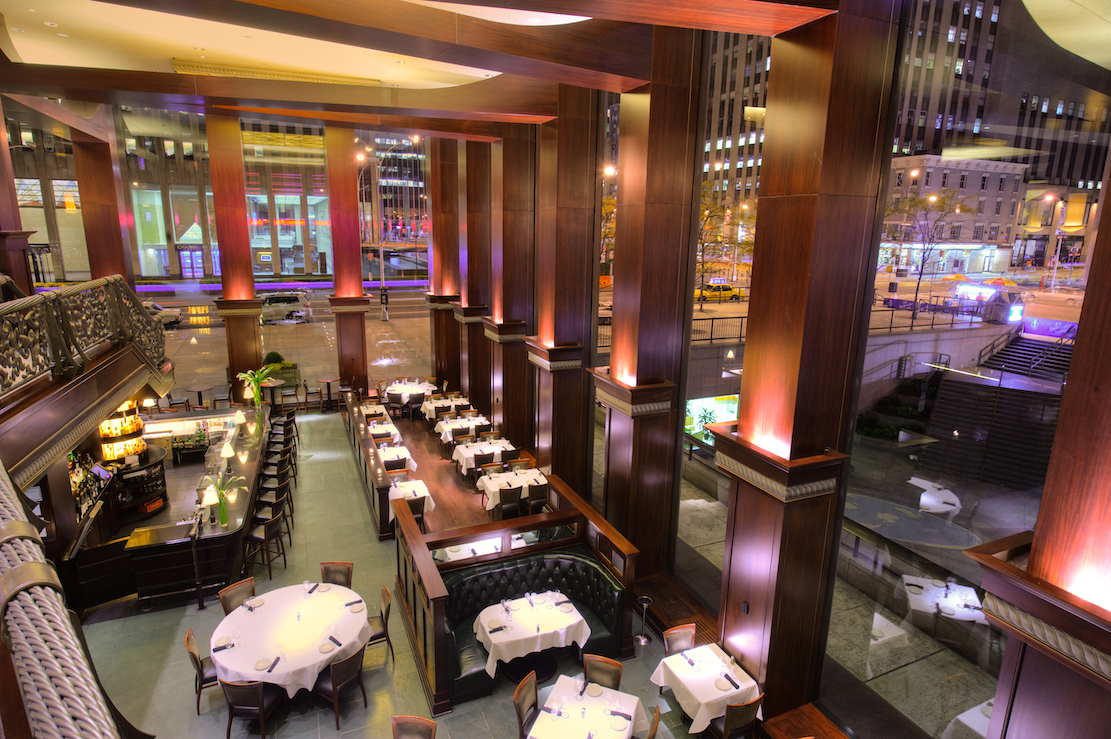
With
sixteen units, Del Frisco’s Double Eagle
Steakhouse chain is larger than Smith &
Wollensky (ten), in range of Palm (24) and way
behind Ruth’s Chris (75). In the steakhouse
game, size is a double-edged sword: on the one
hand, you have clout with the major meat
suppliers, but on the other it’s very difficult
to maintain the same, consistent quality
throughout the chain. When it comes to USDA
Prime beef, a grade that has been de-graded
over the past two decades to meet demand, the
prospects of always getting the very best beef
in a seasonal market become tougher and tougher.
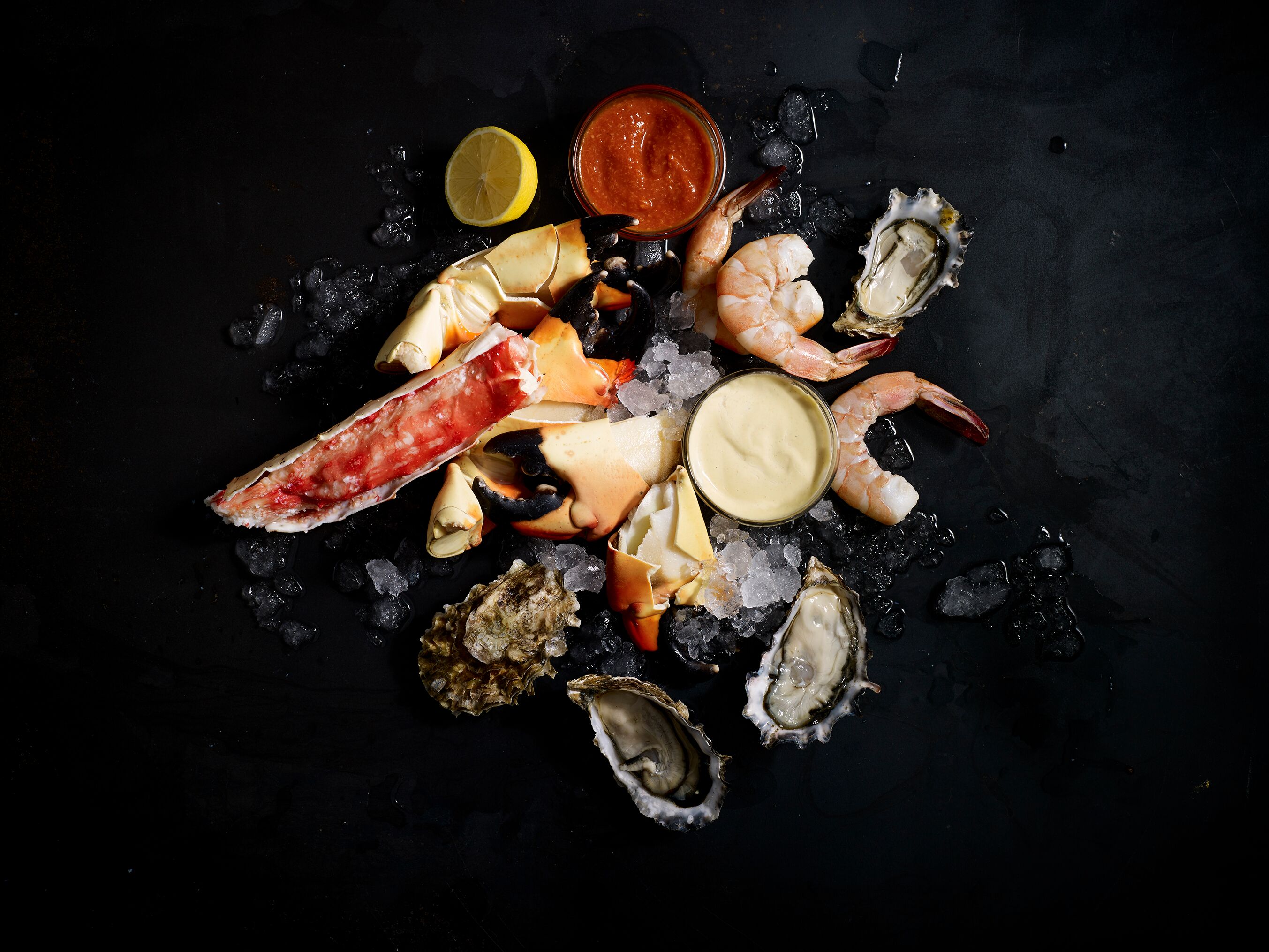 Simple
math tells you that if USDA Prime totals less than
three percent of the American meat supply, you’ll
understand that vying for that minuscule amount
for every new unit that opens doesn’t compute.
Simple
math tells you that if USDA Prime totals less than
three percent of the American meat supply, you’ll
understand that vying for that minuscule amount
for every new unit that opens doesn’t compute.
Del Frisco’s started out
in Dallas in 1981, and, after expansion, acquired
other brands, for a total of 70 restaurants. As of
this writing, the company has just been split up,
with the Connecticut-based equity firm L.
Chatterton buying Del Frisco's Bartaco and
Barcelona Wine Bar brands for $650 million in
cash, while Houston billionaire and Houston
Rockets owner Tilman Fertitta’s Landry’s Inc. has
bought the Del Frisco's Double Eagle Steakhouses
and Grilles for an undisclosed amount. As a result
of the transaction's close, Del
Frisco's stock will cease trading on the
NASDAQ Global Select Market.
Still, I
can’t imagine the new owners doing much to change
the Del Frisco template in any significant way,
not least the New York operation, which is one of
its highest-grossing branches. The New York Del
Frisco’s, with a slightly more casual Del Frisco’s
Grille across the street in Rockefeller Center,
offers pretty much the exact menu as all the other
units do, although prices in New York are higher—a
bone-in ribeye in Atlanta runs $64; in Manhattan,
it’s $76. All
are vast spaces, many on two floors and none is
done in the deliberately scruffy, old-fashioned
look of many of their competitors.
Where
Del Frisco’s does seem to have enormous clout is
in wine buying, and every unit has great depth and
breadth, many with more than 1,200 labels; the
wine list in New York is easily one of the best in
the world, including a slew of trophy wines like 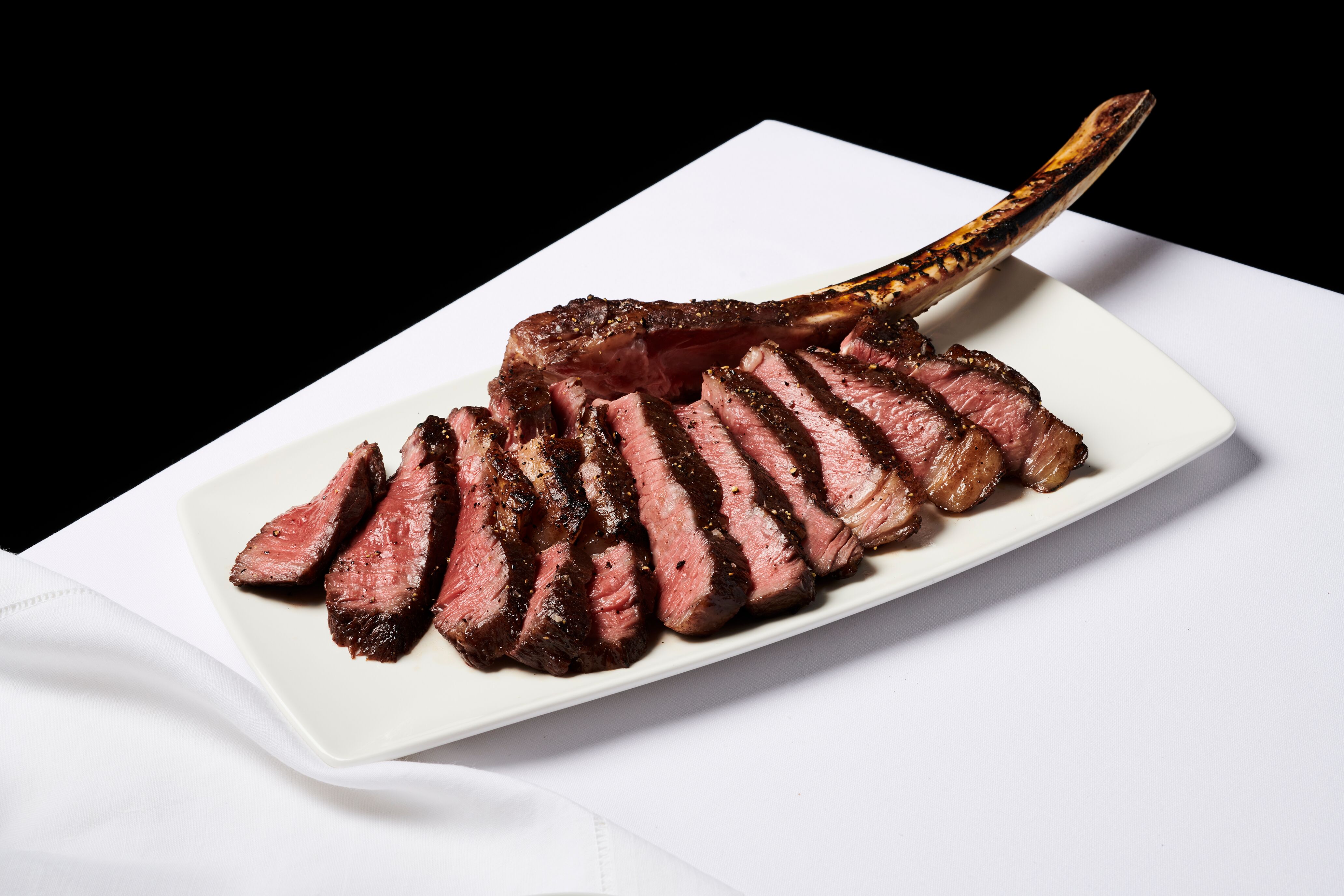 Romanée-Conti
going for an astonishing $29,000.
Romanée-Conti
going for an astonishing $29,000.
The location,
on Sixth Avenue, anchors the skyscraper above it,
taking up two floors, with a fabulous view of the
streets and Rockefeller Center. A sweeping
staircase, a ceiling held up by massive wood-clad
girders, a long U-shaped bar, violet lighting, a
great wine cache behind glass, widely separated
tables and good linens are a departure from the
formulaic in New York steakhouses. Call it Texas
swagger, but the personalities of the wait staff
is pure New York. When full the place can ring
with voices but it’s not too loud. At lunch men
will be in suits and ties, at dinner, all clothing
guidelines are thrown to the wind.
Ask about the oysters of the
moment ($22) and you’ll get a highly informed
answer from the waiter, as you will about every
aspect of the menu. Nicely chopped and spiced tuna
tartare comes with avocado, sweet soy ponzu, a
wakame
salad and wonton crisps ($24.50). Seared foie gras
takes on a strawberry balsamic glaze with toasted
brioche and the unusual addition of crispy onion
($27). And what’s a steakhouse without a good,
crisp blue cheese-stuffed iceberg lettuce wedge
with tomatoes, bacon and rich Danish blue dressing
($14.50)?
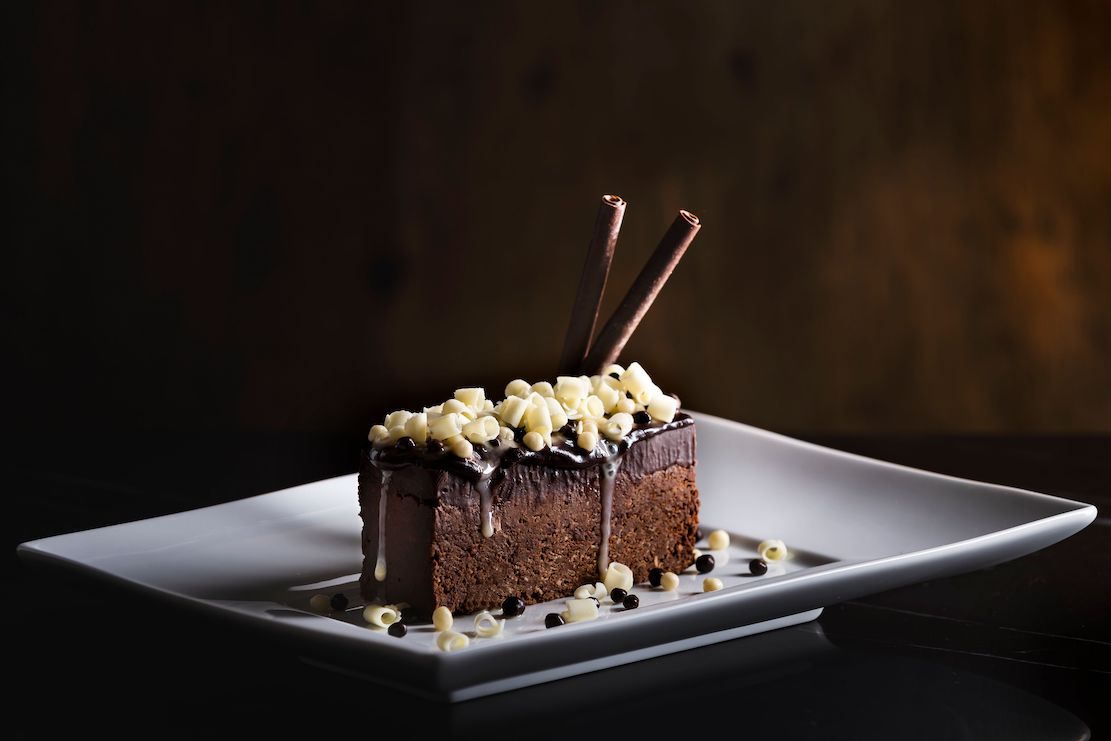 Way
too many steakhouses announce they use “jumbo lump
crab meat,” then serve mashed-up shreds of crab in
their crab cakes. Del Frisco’s promises and
delivers the real thing, big, fat, sweet lumps of
crab lightly bound and quickly sautéed, served
with a lobster cream sauce ($24.50).
Way
too many steakhouses announce they use “jumbo lump
crab meat,” then serve mashed-up shreds of crab in
their crab cakes. Del Frisco’s promises and
delivers the real thing, big, fat, sweet lumps of
crab lightly bound and quickly sautéed, served
with a lobster cream sauce ($24.50).
Among the meat entrees I
sampled, by far the 22-ounce dry-aged Colorado
lamb chops ($64) were the best, with a proper trim
and balance of fat to meat, the right char and
perfect temperature. But a 22-ounce bone-in
ribeye ($76) and a bone-in strip ($68.50) lacked
the richness and minerality I find in some other
New York steakhouses like Palm and Porter House.
Brussels sprouts come with
smoked bacon, caramelized onions for sweetness and
a lemon butter ($16), the creamed spinach with
smoky bacon, egg, mushrooms and Cheddar ($15) are
very good, and the potatoes au gratin with
scallions, bacon and cheddar ($15) delicious.
Steakhouses need to show
largess in everything from bread basket to
desserts, and in this latter category Del Frisco’s
can be boastful: the lemon cake ($13.50) is six
layers tall, with lemon butter cream and a lemon
glaze—this is a good spot to take a friend for a
birthday lunch and order this cake. Butter cake
was made even richer by lavishing it with butter
pecan ice cream, whipped creamed and caramel sauce
($13), and the warm banana bread pudding with
vanilla ice cream and caramel ($12.50) would go
over well in New Orleans.
Of
all the out-of-town chains in New York, like
Morton’s, Ruth’s Chris, Capital Grille and others,
Del Frisco’s competes at a higher level of largess
and swank, plus it runs like a very well-oiled
machine. I trust the break-up into two companies
won’t change that.
Open for lunch Mon.-Sat., for dinner nightly.
❖❖❖
By John Mariani
In
the 1980s Vega Sicilia Unico Put
Ribera Del Duero Wines among
Europe's Finest and Still Does
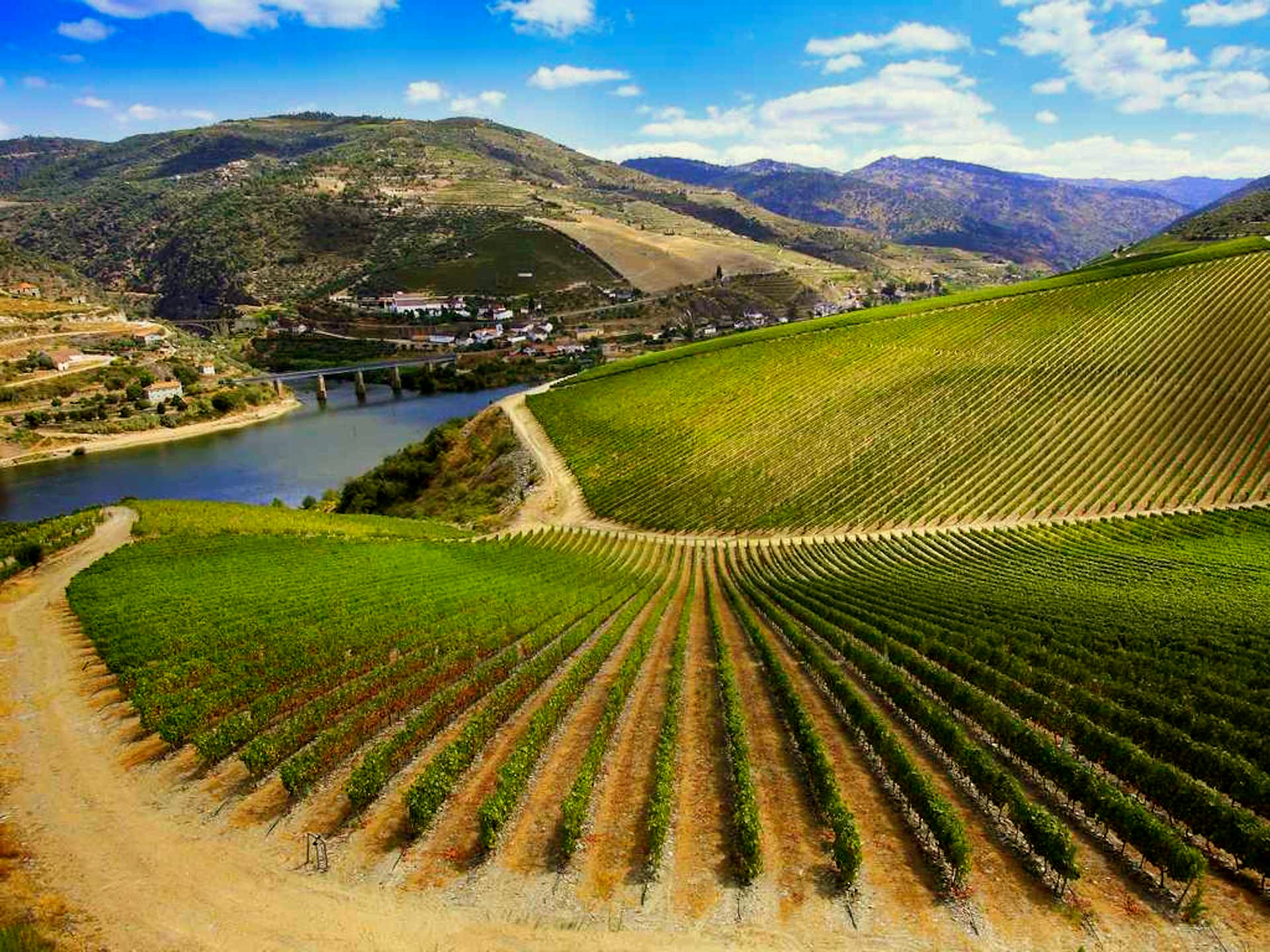
Ribera del
Duero
I
don’t remember the exact moment I
first tasted Vega Sicilia Unico—it was sometime
in the mid-1980s—but I recall being astounded
for two reasons: first, because it was one of
the few premium quality Spanish wines then in
the market, and second, because its quality was
unquestionably at a level of the very best wines
of Bordeaux. Ever since, I’ve felt privileged to
drink Vega Sicilia Unico, not least because its
price has soared upwards of $500.
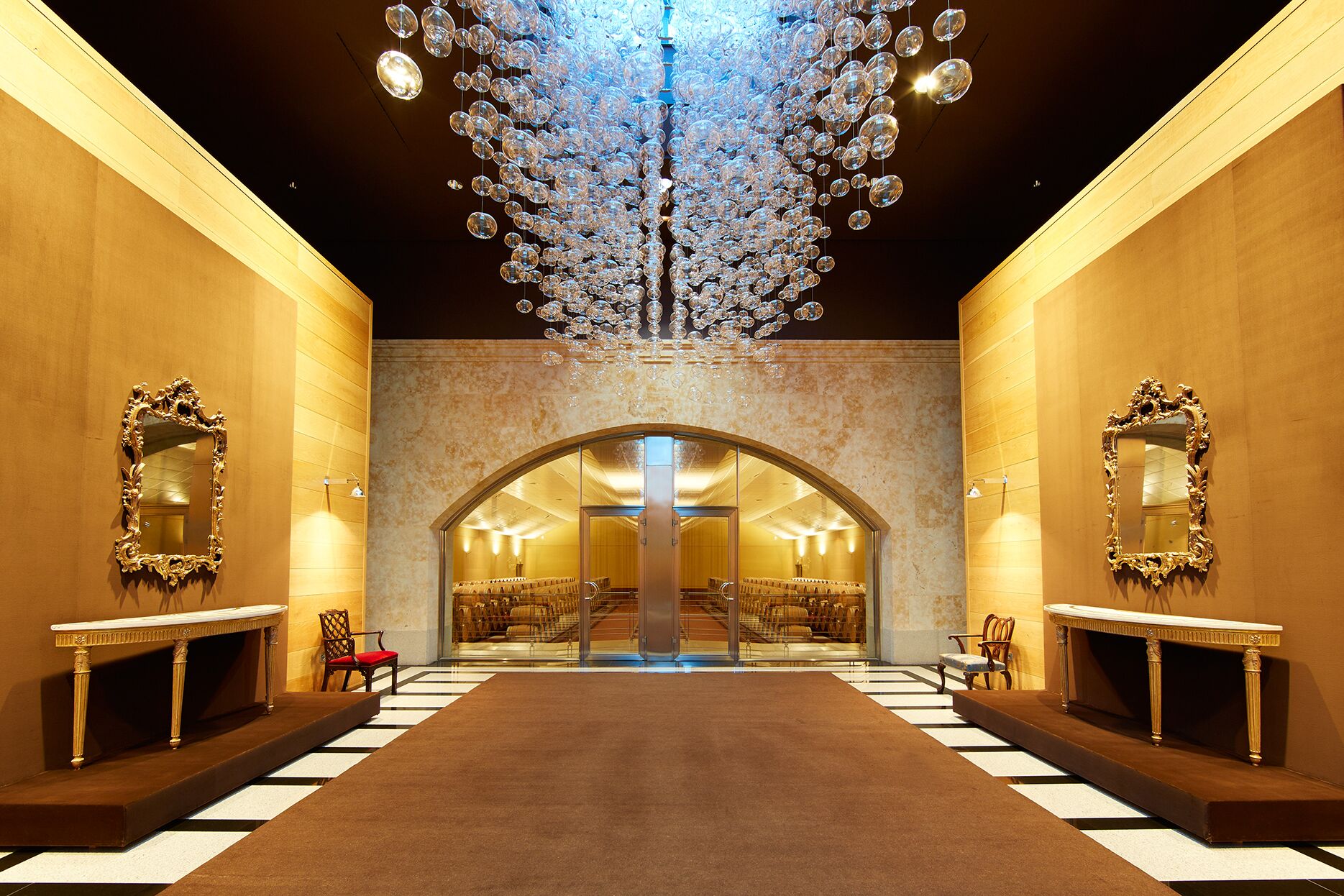 The
vineyards of Bodegas Vega Sicilia, whose name
predates its founding as a winery, are at the
edge of the Ribera
del Duero in the Province
of Valladolid, Castilla y Leon, and the
winery’s fame vaulted that region to the forefront
of Spanish viniculture in the late 1990s.
Originally founded in 1864 by Don Eloy Lecanda y
Chaves, who was extraordinary in his day for
planting Bordeaux varietals like Cabernet
Sauvignon and Merlot in his vineyards, along with
the more traditional plantings of Tempranillo and
Malbec, the winery helped put Ribera del Duero on
the map in 1982 with its own Denominación
de Origen appellation. Also that year
the estate was purchased by the Álvarez family,
who upgraded the estate from top to bottom. Though
production is kept to a modest volume, today its
wines are sold in 88 countries.
The
vineyards of Bodegas Vega Sicilia, whose name
predates its founding as a winery, are at the
edge of the Ribera
del Duero in the Province
of Valladolid, Castilla y Leon, and the
winery’s fame vaulted that region to the forefront
of Spanish viniculture in the late 1990s.
Originally founded in 1864 by Don Eloy Lecanda y
Chaves, who was extraordinary in his day for
planting Bordeaux varietals like Cabernet
Sauvignon and Merlot in his vineyards, along with
the more traditional plantings of Tempranillo and
Malbec, the winery helped put Ribera del Duero on
the map in 1982 with its own Denominación
de Origen appellation. Also that year
the estate was purchased by the Álvarez family,
who upgraded the estate from top to bottom. Though
production is kept to a modest volume, today its
wines are sold in 88 countries.
Tempos Vega Sicilia is very
much a family winery—which went through messy,
divisive intramural disputes over the ownership of
its El Enebro equity company earlier in this
decade—with Pablo Álvarez serving since 1990 as
CEO of Tempos Vega Sicilia as well as the current
Chair of Europvin, an export group of highly
regarded European wineries. 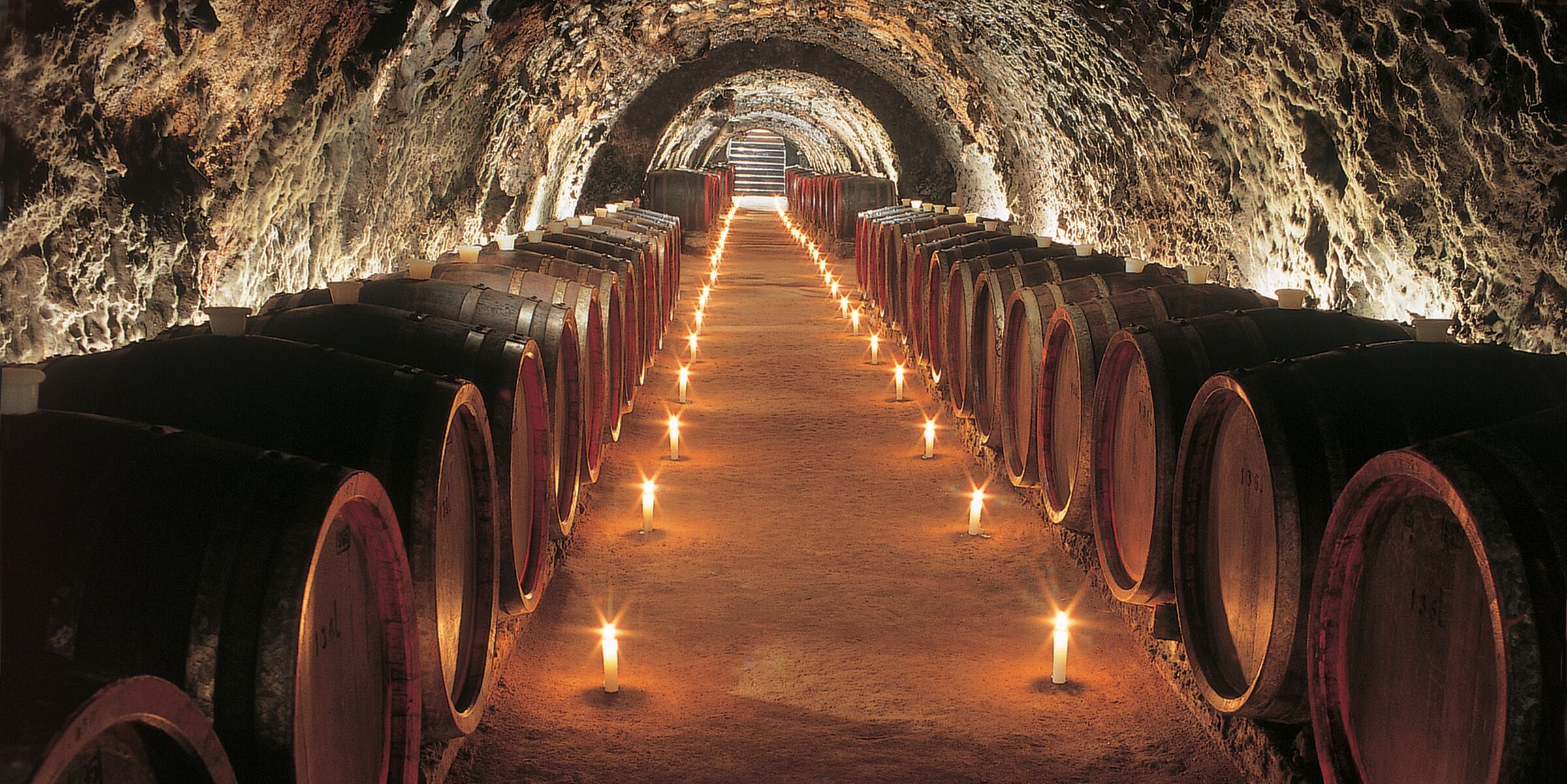 His
daughter Marta Álvarez serves as President.
The Álvarez family is also part of Primum Familiae
Vini, an association of just twelve families that
include Miguel Torres, Robert Drouhin, Piero
Antinori, Mouton-Rothschild and others.
His
daughter Marta Álvarez serves as President.
The Álvarez family is also part of Primum Familiae
Vini, an association of just twelve families that
include Miguel Torres, Robert Drouhin, Piero
Antinori, Mouton-Rothschild and others.
Today the
winery uses more Tempranillo than in the past,
though 40% of its 210 of the estate’s 1000 acres
are still planted with old vine Bordeaux
varietals. Yields are low, with Vega Sicilia’s
signature Unico wines often made from less than a
ton of grapes per acre, accounting for about
one-third of the estate’s production. The current
winemaker is Gonzalo Iturriaga de
Juan, whose blends are usually about 80%
Tempranillo and 20% Cabernet Sauvignon. Unico
2009, however, is made from 94% Tempranillo and 6%
Cabernet Sauvignon. It is also known for its
slow-maturing character, so that keeping it
cellared is essential to bringing it to its finest
expression, sometimes more than two decades after
bottling. In poor vintages, the wine may not be
made or labeled Unico at all. Vega Sicilia Unico
Reserva Especial’s label shows no vintage at all,
but is a blend of various vintages that may date
back 30 years.
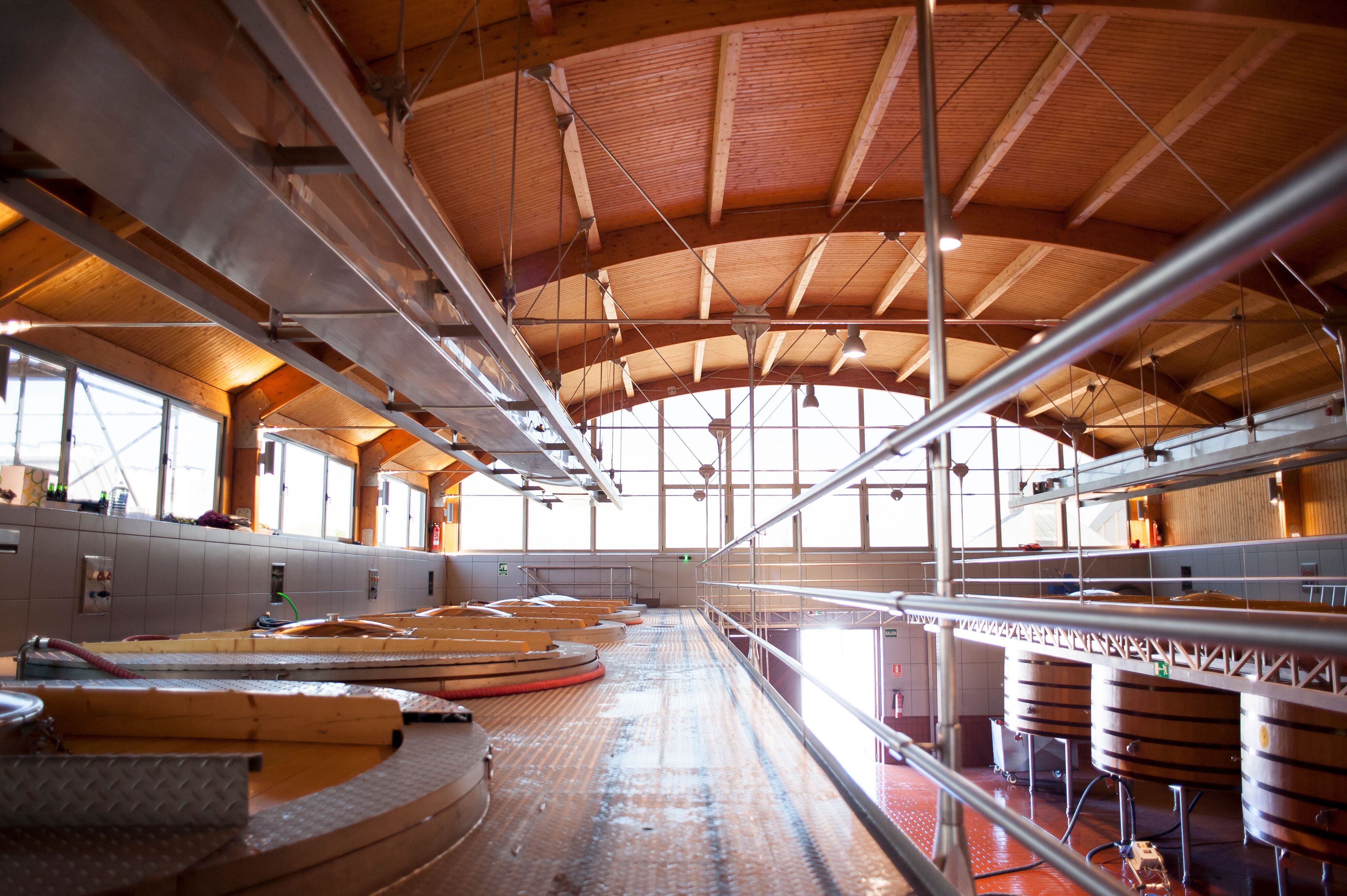 Recently in
New York, Pablo Alvarez held a tasting of the
estate’s wines at a Japanese restaurant, which I
thought an odd match-up and found to be less than
stimulating. Nevertheless, from the first sips of
the Macán Clásico Rioja 2015 ($60) and Macán Rioja
2014 ($100), I was reminded again of what I love
about these wines. These are from a joint venture
with Benjamin de Rothschild that began in 2004 and
released its first wines in 2009. They are 100%
Tempranillo from vineyards averaging 40 years of
age, spending 16 to 18 months in barrel and three
years in bottle, emerging with a borderline-high
14.5% alcohol. Álvarez said that because the wines
come from northern vineyards, “They are not so
explosive,” yet I found the rich, fruit-driven
Rioja delightful right now, with the Clásico tight
on first smell and taste, but it opened up on the
glass.
Recently in
New York, Pablo Alvarez held a tasting of the
estate’s wines at a Japanese restaurant, which I
thought an odd match-up and found to be less than
stimulating. Nevertheless, from the first sips of
the Macán Clásico Rioja 2015 ($60) and Macán Rioja
2014 ($100), I was reminded again of what I love
about these wines. These are from a joint venture
with Benjamin de Rothschild that began in 2004 and
released its first wines in 2009. They are 100%
Tempranillo from vineyards averaging 40 years of
age, spending 16 to 18 months in barrel and three
years in bottle, emerging with a borderline-high
14.5% alcohol. Álvarez said that because the wines
come from northern vineyards, “They are not so
explosive,” yet I found the rich, fruit-driven
Rioja delightful right now, with the Clásico tight
on first smell and taste, but it opened up on the
glass.
Next up was Pintia Toro 2014
($75), which Álvarez called a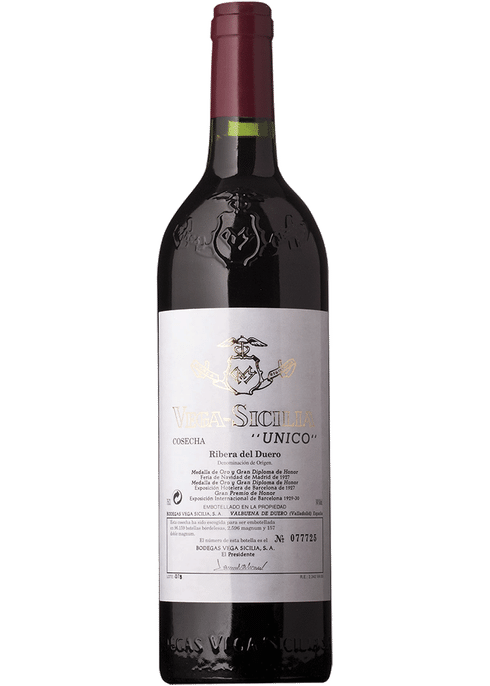 “rustic wine.” Seventy-five acres
used for Pintia is planted with pre-phylloxera
vines, and the company also buys grapes from
others. The Toro appellation soil is very pebbly,
so it has a fine minerality. A “polishing” takes
place from malolactic fermentation, spending time
in both French and American oak that provides a
woodsy, not woody, character and fruited lush
texture, with 14.5% alcohol, bottled in May 2016.
“rustic wine.” Seventy-five acres
used for Pintia is planted with pre-phylloxera
vines, and the company also buys grapes from
others. The Toro appellation soil is very pebbly,
so it has a fine minerality. A “polishing” takes
place from malolactic fermentation, spending time
in both French and American oak that provides a
woodsy, not woody, character and fruited lush
texture, with 14.5% alcohol, bottled in May 2016.
Alion
2015 ($95) was minty, peppery and drier, made from
complementary plots throughout Ribera del Duero,
aged in 80% new oak barrels, the rest is used
barriques, which explains its spicy freshness. At
15% alcohol it is getting a bit too fleshy but
more time in the cellar may tamp its effects down.
Valbuena 5º Ribera del Duero
2014 ($200) came next with some washu beef,
parmesan-dusted spinach and black truffles, which
worked well. Five years of aging shows this blend
of 95% Tinto Fino 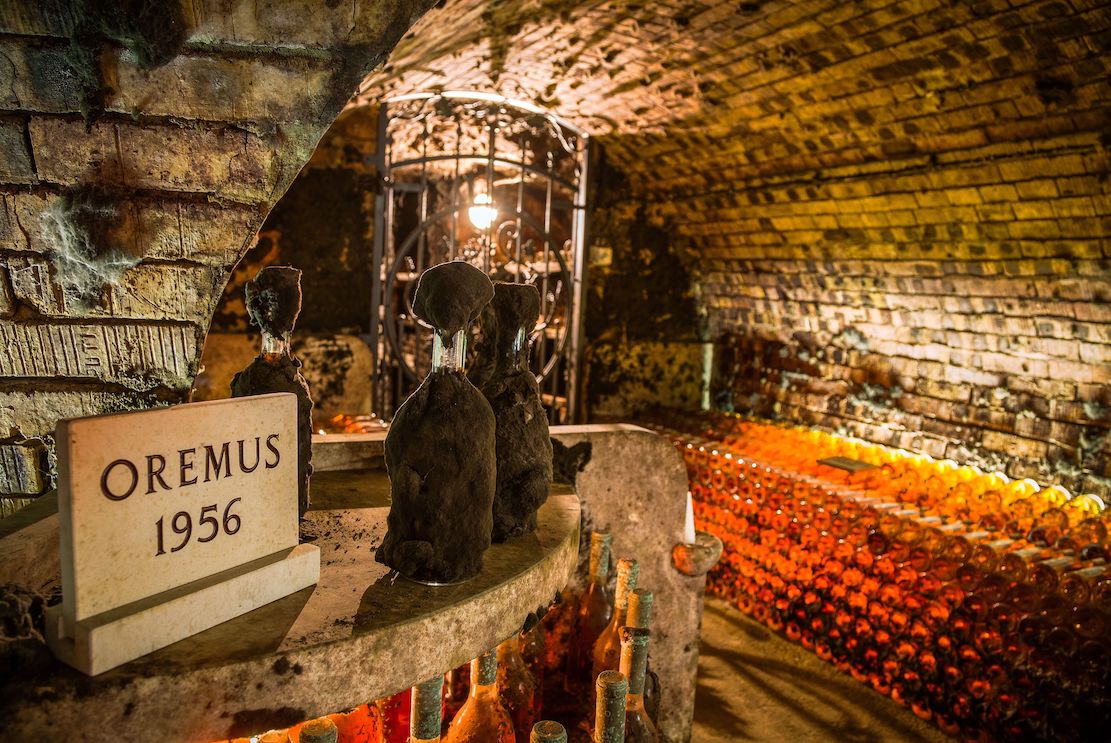 and 5%
Merlot, which gives it a velvety quality, has
softening tannins but a true balance of fruit and
acid, at a perfect 14% alcohol.
Then came the masterwork, Unico
2009, with a complexity achieved through careful
selection from 57 plots with 19 soil types, each
with its own characteristics. The blend for this
vintage was 94% Tinto Fino and 6% Cabernet
Sauvignon. Ten years of aging is the minimum for a
wine of this stature, with many years of maturity
ahead of it, and it achieves its depth and breadth
at only 14% alcohol. Everything I recall with such
pleasure from the first time I had Vega Sicilia
Unico came flooding back that evening. (Current
prices in the U.S. range from $335 to $500 a
bottle.)
and 5%
Merlot, which gives it a velvety quality, has
softening tannins but a true balance of fruit and
acid, at a perfect 14% alcohol.
Then came the masterwork, Unico
2009, with a complexity achieved through careful
selection from 57 plots with 19 soil types, each
with its own characteristics. The blend for this
vintage was 94% Tinto Fino and 6% Cabernet
Sauvignon. Ten years of aging is the minimum for a
wine of this stature, with many years of maturity
ahead of it, and it achieves its depth and breadth
at only 14% alcohol. Everything I recall with such
pleasure from the first time I had Vega Sicilia
Unico came flooding back that evening. (Current
prices in the U.S. range from $335 to $500 a
bottle.)
An
unexpected pleasure at dinner’s end was a Late
Harvest Oremus 2017 from Hungary, whose estate
Tempos Vega Sicilia bought, acquiring vineyards
that average 20 years old, which was the period
when Hungarian vineyards had emerged from decades
of Soviet mismanagement. The wine is aged,
appropriately, in oak barrels called Gōnc and
Szerednye then aged for six months in bottle. (A
500-ml bottle runs about $40.) It was a happy
surprise along with a dessert of traditional
Portuguese-Japanese sponge cake called castella with
chestnuts and sweet potato cream.

AFTER
MISSING OUT ON THE CONTRACT
FOR THE
COSMOPOLITAN ACCOUNT. . .
Sarah Jessica Parker’s new Sauvignon Blanc wine
“Invivo X, Sarah Jessica Parker” is the
actress / entrepreneur’s first wine to launch from
her new collection with New Zealand-based Invivo
& Co. She said, "I’ve been so looking forward to
releasing my Invivo X, Sarah Jessica Parker
Sauvignon Blanc and sharing it with the world. The
whole marvelous experience was a great and
unexpected opportunity and yes, at last we get to
introduce the fruits of these last many months. We
are thrilled to pour our first glasses, delight in
imagining others do so and hope very much that you
love it as much as we do.” The wine "was perfected"
in May 2019 during a 3-hour blending session in NYC
with Parker and Invivo’s co-foundersRob
Cameron & Tim Lightbourne.
Says Cameron of the wine, it has “Lifted notes of
grapefruit, honeysuckle flower, passionfruit and
citrus zest. The palate is expansive and leads with
a wall of sweet-scented fruits and a soft, but
balanced acid spine.”

"A trip to the bar with a young kid can be a
disaster, but there are steps you can take to ensure
that everyone has a good time," by "The
Right Way to Bring a Baby to a Bar," Eater.com (
Any of John Mariani's books below may be ordered from amazon.com.
 The Hound in Heaven
(21st Century Lion Books) is a novella, and
for anyone who loves dogs, Christmas, romance,
inspiration, even the supernatural, I hope you'll find
this to be a treasured favorite. The story
concerns how, after a New England teacher, his wife and
their two daughters adopt a stray puppy found in their
barn in northern Maine, their lives seem full of promise.
But when tragedy strikes, their wonderful dog Lazarus and
the spirit of Christmas are the only things that may bring
his master back from the edge of despair.
The Hound in Heaven
(21st Century Lion Books) is a novella, and
for anyone who loves dogs, Christmas, romance,
inspiration, even the supernatural, I hope you'll find
this to be a treasured favorite. The story
concerns how, after a New England teacher, his wife and
their two daughters adopt a stray puppy found in their
barn in northern Maine, their lives seem full of promise.
But when tragedy strikes, their wonderful dog Lazarus and
the spirit of Christmas are the only things that may bring
his master back from the edge of despair. WATCH THE VIDEO!
“What a huge surprise turn this story took! I was completely stunned! I truly enjoyed this book and its message.” – Actress Ali MacGraw
“He had me at Page One. The amount of heart, human insight, soul searching, and deft literary strength that John Mariani pours into this airtight novella is vertigo-inducing. Perhaps ‘wow’ would be the best comment.” – James Dalessandro, author of Bohemian Heart and 1906.
“John Mariani’s Hound in Heaven starts with a well-painted portrayal of an American family, along with the requisite dog. A surprise event flips the action of the novel and captures us for a voyage leading to a hopeful and heart-warming message. A page turning, one sitting read, it’s the perfect antidote for the winter and promotion of holiday celebration.” – Ann Pearlman, author of The Christmas Cookie Club and A Gift for my Sister.
“John Mariani’s concise, achingly beautiful novella pulls a literary rabbit out of a hat – a mash-up of the cosmic and the intimate, the tragic and the heart-warming – a Christmas tale for all ages, and all faiths. Read it to your children, read it to yourself… but read it. Early and often. Highly recommended.” – Jay Bonansinga, New York Times bestselling author of Pinkerton’s War, The Sinking of The Eastland, and The Walking Dead: The Road To Woodbury.
“Amazing things happen when you open your heart to an animal. The Hound in Heaven delivers a powerful story of healing that is forged in the spiritual relationship between a man and his best friend. The book brings a message of hope that can enrich our images of family, love, and loss.” – Dr. Barbara Royal, author of The Royal Treatment.
 |
The Encyclopedia of American Food and Drink by John F. Mariani (Bloomsbury USA, $35) Modesty forbids me to praise my own new book, but let me proudly say that it is an extensive revision of the 4th edition that appeared more than a decade ago, before locavores, molecular cuisine, modernist cuisine, the Food Network and so much more, now included. Word origins have been completely updated, as have per capita consumption and production stats. Most important, for the first time since publication in the 1980s, the book includes more than 100 biographies of Americans who have changed the way we cook, eat and drink -- from Fannie Farmer and Julia Child to Robert Mondavi and Thomas Keller. "This book is amazing! It has entries for everything from `abalone' to `zwieback,' plus more than 500 recipes for classic American dishes and drinks."--Devra First, The Boston Globe. "Much needed in any kitchen library."--Bon Appetit. |
"Eating Italian will never be the same after reading John Mariani's entertaining and savory gastronomical history of the cuisine of Italy and how it won over appetites worldwide. . . . This book is such a tasteful narrative that it will literally make you hungry for Italian food and arouse your appetite for gastronomical history."--Don Oldenburg, USA Today. "Italian
restaurants--some good, some glitzy--far
outnumber their French rivals. Many of
these establishments are zestfully described
in How Italian Food Conquered the World, an
entertaining and fact-filled chronicle by
food-and-wine correspondent John F.
Mariani."--Aram Bakshian Jr., Wall Street
Journal.
"Equal parts
history, sociology, gastronomy, and just
plain fun, How Italian Food Conquered the
World tells the captivating and delicious
story of the (let's face it) everybody's
favorite cuisine with clarity, verve and
more than one surprise."--Colman Andrews,
editorial director of The Daily
Meal.com. "A fantastic and fascinating
read, covering everything from the influence
of Venice's spice trade to the impact of
Italian immigrants in America and the
evolution of alta cucina. This book will
serve as a terrific resource to anyone
interested in the real story of Italian
food."--Mary Ann Esposito, host of PBS-TV's
Ciao
Italia. "John Mariani has written the
definitive history of how Italians won their
way into our hearts, minds, and
stomachs. It's a story of pleasure over
pomp and taste over technique."--Danny Meyer,
owner of NYC restaurants Union Square
Cafe, The Modern, and Maialino.
|
 |
 |
 |
 |
 |
 |
 |
 |
 Everett Potter's Travel Report:
Everett Potter's Travel Report: 
 Eating Las Vegas
JOHN CURTAS has been covering the Las Vegas
food and restaurant scene since 1995. He is
the co-author of EATING LAS VEGAS – The 50
Essential Restaurants (as well as
the author of the Eating Las Vegas web site: www.eatinglasvegas.
He can also be seen every Friday morning as
the “resident foodie” for Wake Up With the
Wagners on KSNV TV (NBC) Channel 3 in
Las Vegas.
Eating Las Vegas
JOHN CURTAS has been covering the Las Vegas
food and restaurant scene since 1995. He is
the co-author of EATING LAS VEGAS – The 50
Essential Restaurants (as well as
the author of the Eating Las Vegas web site: www.eatinglasvegas.
He can also be seen every Friday morning as
the “resident foodie” for Wake Up With the
Wagners on KSNV TV (NBC) Channel 3 in
Las Vegas.
MARIANI'S VIRTUAL GOURMET
NEWSLETTER is published weekly. Publisher: John Mariani. Editor: Walter Bagley. Contributing Writers: Christopher Mariani,
Robert Mariani, Misha Mariani, John A. Curtas, Gerry Dawes, Geoff Kalish,
and Brian Freedman. Contributing
Photographer: Galina Dargery. Technical
Advisor: Gerry
McLoughlin.
If you wish to subscribe to this
newsletter, please click here: http://www.johnmariani.com/subscribe/index.html
© copyright John Mariani 2019

